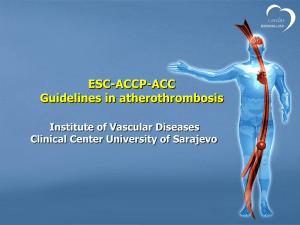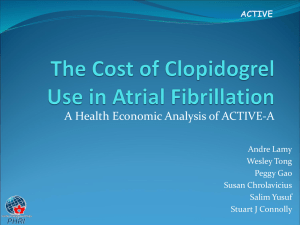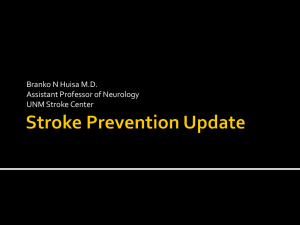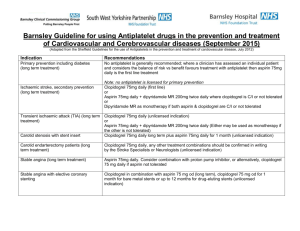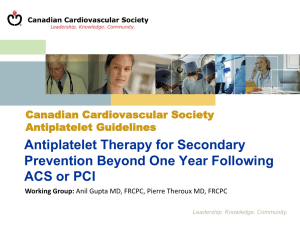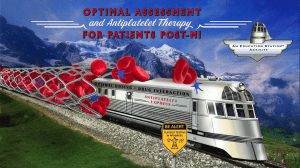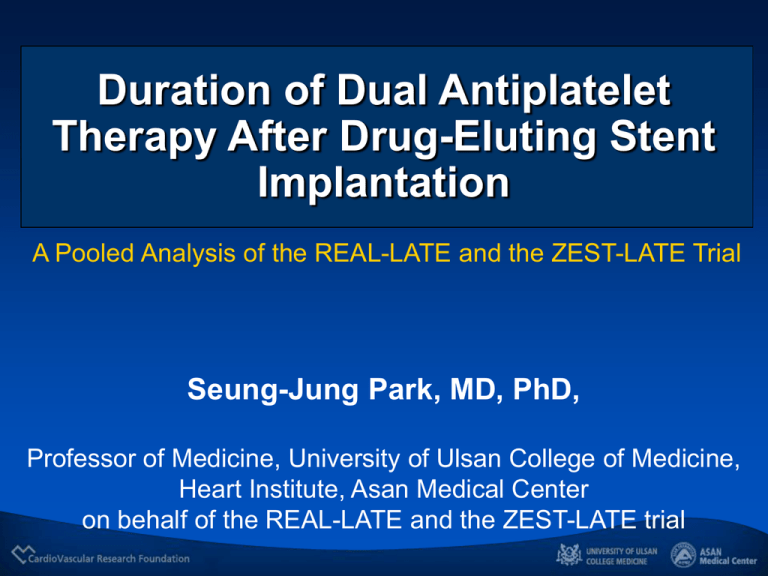
Duration of Dual Antiplatelet
Therapy After Drug-Eluting Stent
Implantation
A Pooled Analysis of the REAL-LATE and the ZEST-LATE Trial
Seung-Jung Park, MD, PhD,
Professor of Medicine, University of Ulsan College of Medicine,
Heart Institute, Asan Medical Center
on behalf of the REAL-LATE and the ZEST-LATE trial
Disclosure Information
Supported by research grants from
by the Cardiovascular Research Foundation,
Seoul, Korea, and a grant from the Korea Health
21 R&D Project, Ministry of Health and Welfare,
Korea (0412-CR02-0704-0001).
No industry sponsorship relevant to this study
BACKGROUND
•
•
•
Early discontinuation of dual antiplatelet therapy has been
identified as a risk factor for late stent thrombosis with drugeluting stents.
Current PCI guidelines recommend that clopidogrel 75 mg daily
should be given for at least 12 months after implantation of
DES if patients are not at high risk of bleeding.
However, the optimal duration of dual antiplatelet therapy and
the risk–benefit ratio of long-term dual antiplatelet therapy
remain uncertain for patients receiving DES
OBJECTIVE
•
•
The findings of observational studies have been inconsistent,
and no randomized trials have been performed to address
this issue.
Accordingly, we evaluated the effect of extended dual
antiplatelet therapy beyond 12 months on long-term clinical
outcomes in patients who underwent initial PCI with drugeluting stents.
METHODS
STUDY DESIGN
• The current analysis merged data from two
concurrent randomized, clinical trials comparing
continuation and discontinuation of clopidogrel in
patients who were free of major adverse cardiac or
cerebrovascular events and major bleeding for at
least 12 month period after implantation of drugeluting stents.
STUDY DESIGN
•
•
The first trial was called REAL-LATE (Correlation of
Clopidogrel Therapy Discontinuation in REAL-world Patients
treated with Drug-Eluting Stent Implantation and Late
Coronary Arterial Thrombotic Events; ClinicalTrials.gov
number, NCT00484926)
The second trial was called ZEST-LATE (Evaluation of the
Long-term Safety After Zotarolimus-Eluting Stent, SirolimusEluting Stent, or PacliTaxel-Eluting Stent Implantation for
Coronary Lesions - Late Coronary Arterial Thrombotic Events;
ClinicalTrials.gov number, NCT00590174)
STUDY DESIGN
•
•
The study designs of the two trials were similar; the main
difference was that the ZEST-LATE trial included only
individuals who had participated in another randomized trial,
the ZEST(Comparison of the Efficacy and the Safety of
Zotarolimus-Eluting Stent versus Sirolimus-Eluting Stent and
Paclitaxel-Eluting Stent for Coronary Lesions, NCT00418067).
The REAL-LATE trial enrolled a broader population of patients
without limiting the clinical or lesion characteristics.
STUDY DESIGN
• These two trials (the REAL-LATE and ZEST-LATE)
were merged as the result of a decision of the
executive committees, on the basis of the slowerthan-anticipated enrollment in each of the trials and
substantial similarities in their designs.
• The data and safety monitoring board, which was
the same for both trials, agreed to the merger.
STUDY DESIGN
REAL-LATE
Broader population of
patients who had
received any DES
ZEST-LATE
Patients who had
participated in ZEST
trial
Patients who
were free of
MACCE with
Dual antiplatelet
therapy for at
least a 12 month
after DES
implantation
Clopidogrel + Aspirin
R
Aspirin Alone
1
2 year
Clinical follow-up every 6 months
Composite of MI or Death
from cardiac causes
STUDY POPULATION
Inclusion Criteria
Patients were eligible to enroll in the REAL-LATE and ZESTLATE trials if they had undergone implantation of a drug-eluting
stents at least 12 months before enrollment, had not had a
major adverse cardiovascular event (myocardial infarction,
stroke, or repeat revascularization) or major bleeding since
implantation, and were receiving dual antiplatelet therapy at the
time of enrollment.
STUDY POPULATION
Exclusion Criteria
• Contraindications to use of antiplatelet drugs.
• Concomitant vascular disease requiring long-term use of
clopidogrel or other established indications for clopidogrel
therapy (e.g., a recent acute coronary syndrome)
• Non-cardiac co-morbid conditions with life expectancy <1 year
• Participants in another drug or coronary-device study.
TRIAL PROCEDURES AND FOLLOW-UP
• Patients in both trials were randomly assigned either to
•
•
•
clopidogrel (75 mg per day) plus low-dose aspirin (100 to 200
mg per day) or low-dose aspirin alone.
The treatment allocation was performed using a preestablished,
computer-generated randomization scheme, stratified
according to site and type of DES.
Both were open-label trials without blinding of either the study
subjects or the investigators.
Follow-up evaluations were performed every 6 months. At these
visits, data pertaining to patients’ clinical status, all interventions,
outcome events, adverse events, and drug compliance were
recorded.
END POINTS
The Primary End Points
The first occurrence of myocardial infarction or death
from cardiac cause after treatment assignment.
The Principal Secondary End Points
• Each component of death, myocardial infarction, stroke (of any
cause), definite stent thrombosis, or repeat revascularization
• Composite death or myocardial infarction
• Composite death, myocardial infarction or stroke
• Composite cardiac death, myocardial infarction, or stroke
• Major bleeding, according to the TIMI definition.
SAMPLE SIZE ESTIMATION
• The assumed rates of the primary end point and the assumed
relative risk reduction were based on historical data (the
BASEKET-LATE study and the Duke registry data).
• Assuming an event rate of 5.0% at 2 years for the primary end
point among patients who were assigned to the aspirin-alone
group, we estimated that 1,812 patients (906 per group) would
need to be enrolled for the detection of a 50% reduction in
relative risk of the primary end point in the dual-therapy group
as compared with aspirin-alone group, with a statistical power
80% power at a two-sided significance level of 0.05.
• The planned sample size was increased by 10 % to allow for
noncompliance and loss to follow-up, for a total overall
enrollment goal of 2000 patients for each trial.
STATISTICAL ANALYSIS
• All enrolled patients from both trials were included in the
•
•
•
•
analysis of primary and secondary clinical outcomes according
to the intention-to-treat principle.
Differences between treatment groups were evaluated by
Student’s t-test for continuous variables and by the chi-square
or Fisher’s exact test for categorical variables.
Cumulative event curves were generated by means of the
Kaplan-Meier method.
We used a Cox proportional-hazards model to compare clinical
outcomes between the groups.
An additional stratified Cox regression analysis was performed
to test whether merging of the data from the two trials would
influence the primary outcome.
PARTICIPANTS
Seung-Jung Park
Yangsoo Jang
Ki Bae Seung
Hyo-Soo Kim
Seung-Jae Tahk
Myung Ho Jeong
In-Whan Seong
Joo-Young Yang
Seung-Ho Hur
Jae-Gun Chae
Sang-Sig Cheong
Sang-Gon Lee
Nae-Hee Lee
Young-Jin Choi
Taeg Jong Hong
Kee-Sik Kim
Hun Sik Park
Junghan Yoon
Do-Sun Lim
Asan Medical Center, Seoul
Yonsei University Medical Center, Seoul
Catholic Medical Center, Seoul
Seoul National University Hospital, Seoul
Ajou University Hospital, Suwon
Chonnam National University Hospital, Gwangju
Chungnam National University Hospital, Daejeon
NHIC Ilsan Hospital, Ilsan
Keimyung University Dongsan Medical Center, Daegu
Chonbuk National University Hospital, Jeonju
Asan Medical Center, GangNeung
Ulsan University Hospital, Ulsan
Soonchunhyang University Bucheon Hospital, Bucheon
Hallym University Sacred Heart Hospital, PyeongChon
Daegu Catholic University Medical Center, Daegu
Pusan Natioanal University Hospital, Pusan
Kyungpook National University Hospital, Daegu
Yonsei University Wonju Christian Hospital, Wonju
Korea University Hospital, Seoul
CLINICAL TRIAL ORGANIZATION
Principal
Investigators
Clinical Events Committee
Seung-Jung Park, MD, PhD
Asan Medical Center
Jae-Joong Kim, MD, PhD
Asan Medical Center
Data Safety
Monitoring Board
Moo-Song Lee, MD, PhD
Data Coordination/
Site Management
Angiographic Core Lab
Clinical Research Center
Asan Medical Center
CVRF in Korea
University of Ulsan Medical College
RESULTS
STUDY PATIENTS
REAL-LATE
N=1,625
Broader population of
patients who had
received any DES
ZEST-LATE
N=1,357
Patients who had
participated in ZEST
trial
N=2,701
Patients who
were free of
MACCE with
dual antiplatelet
therapy for at
least a 12 month
after DES
implantation
N=1,357
Clopidogrel + Aspirin
R
N=1,344
Aspirin Alone
1
From July 2007 through September 2008
2 year
Clinical follow-up every 6 months
Composite of MI or Death from cardiac causes
Baseline Patients Characteristics
Clopidogrel +
Aspirin
(n=1357)
Aspirin
Alone
(n=1344)
P
Value
Age (yr)
62.0±9.8
61.9±9.9
0.97
Male sex
950 (70.0)
933 (69.4)
0.74
Diabetes mellitus
340 (25.1)
364 (27.1)
0.23
Hypertension
775 (57.1)
765 (56.9)
0.92
Hyperlipidemia
586 (43.2)
584 (43.5)
0.89
Current smoker
404 (29.8)
431 (32.1)
0.20
Previous coronary angioplasty
177 (13.0)
159 (11.8)
0.34
Previous myocardial infarction
51 (3.8)
45 (3.3)
0.57
Previous stroke
57 (4.2)
45 (3.3)
0.25
Characteristic
Demographics
Clinical Characteristics
Clopidogrel +
Aspirin
(n=1357)
Aspirin
alone
(n=1344)
P
Value
Ejection fraction (%)
59.2±9.3
59.7±8.5
0.20
Multivessel disease
667 (49.2)
633 (47.1)
0.29
Characteristic
Clinical indication
0.79
Stable angina
514 (37.9)
500 (37.2)
Unstable angina
543 (40.0)
559 (41.6)
NSTEMI
145 (10.7)
144 (10.7)
STEMI
155 (11.4)
141 (10.5)
Aspirin
1353 (99.7)
1399 (99.6)
0.73
Clopidogrel
1353 (99.7)
1343 (99.9)
0.38
ACE inhibitor
633 (46.6)
603 (44.9)
0.35
ß-blockers
917 (67.6)
869 (64.7)
0.11
Calcium channel blocker
730 (53.8)
739 (55.0)
0.54
Statin
1081 (79.7)
1058 (78.7)
0.55
Discharge medications
Baseline Lesions Characteristics
Characteristic
Lesions stented, No
Clopidogrel +
Aspirin
(n=1357)
Aspirin
Alone
(n=1344)
1872
1847
Vessel treated
Left anterior descending artery
P
Value
0.35
912 (48.7)
921 (49.9)
372 (19.9)
334 (18.1)
533 (28.5)
546 (29.6)
55 (2.9)
44 (2.4)
Bifurcation
226 (12.1)
231 (12.5)
0.69
Ostial location
125 (6.7)
128 (6.9)
0.76
B2 or C type
1494 (79.8)
1461 (79.1)
0.59
Calcification
80 (4.3)
91 (4.9)
0.34
219 (11.7)
190 (10.3)
0.17
Left circumflex artery
Right coronary artery
Left main disease
Total occlusion
Baseline Procedural Characteristics
Clopidogrel
+Aspirin
(n=1357)
Aspirin
Alone
(n=1344)
Lesions stented, No
1872
1847
Stents per lesion, No.
1.3±0.5
1.2±0.5
0.13
31.8±16.4
30.9±15.4
0.07
Characteristic
Stent length per lesion, mm
Type of drug-eluting stents
0.98
Sirolimus-eluting stents
1057 (56.6)
1052 (57.0)
Paclitaxel-eluting stents
456 (24.4)
439 (23.8)
Zotarolimus-eluting stents
350 (18.7)
347 (18.8)
9 (0.5)
9 (0.5)
Others
P
Value
Timing of Randomization after the Index PCI
Characteristic
Clopidogrel +
Aspirin
(n=1357)
Aspirin
Alone
(n=1344)
Time to randomization
0.86
12 Mo – 18 Mo after procedure
1189 (87.6)
1187 (88.3)
18 Mo – 24 Mo after procedure
167 (12.3)
156 (11.6)
1 (0.1)
1 (0.1)
12.8 (12.2–14.6)
12.8 (12.2–14.8)
>24 Mo after procedure
Median (interquartile range)
P Value
Status of Antiplatelet Therapy during Follow up
Aspirin
Alone
(n=1344)
P Value
1348/1357 (99.3)
1338/1344 (99.6)
0.45
1338/1349 (99.2)
1328/1333 (99.6)
0.14
12 Mo after randomization
1129/1143 (98.8)
1103/1117 (98.7)
0.95
18 Mo after randomization
752/759 (99.1)
722/730 (98.9)
0.37
24 Mo after randomization
327/333 (98.2)
313/318 (98.4)
0.82
1335/1357 (98.4)
59/1344 (4.4)
<0.001
1297/1349 (96.1)
78/1332 (5.9)
<0.001
12 Mo after randomization
1011/1143 (88.5)
72/1117 (6.4)
<0.001
18 Mo after randomization
654/758 (86.3)
46/730 (6.3)
<0.001
24 Mo after randomization
276/333 (82.9)
14/318 (4.4)
<0.001
Characteristic
Clopidogrel +
Aspirin
(n=1357)
Aspirin
At randomization
6 Mo after randomization
Clopidogrel
At randomization
6 Mo after randomization
FOLLOW UP AND
CLINICAL OUTCOMES
Primary End Point:
Cardiac Death or Myocardial Infarction
Aspirin Alone
Aspirin Alone
Clopidogrel +
Aspirin
Clopidogrel +
Aspirin
0.7
1.8
1.2
0.5
Log-rank, P=0.17
No. at Risk
Continuation group
1357
Discontinuation group 1344
1122
1100
299
301
Outcome
Total Events
Cumulative Event
Rate At 12 Months
Cumulative Event
Rate At 24 Months
Hazard Ratio
(95% CI)
P
Value
Dual
Therapy
Aspirin
Only
Dual
Therapy
Aspirin
Only
Dual
Therapy
Aspirin
Only
20
12
0.7
0.5
1.8
1.2
1.65 (0.80-3.36)
0.17
Death
20
13
0.5
0.5
1.6
1.4
1.52 (0.75-3.5)
0.24
MI
10
7
0.4
0.3
0.8
0.7
1.41 (0.54-3.71)
0.49
Stroke
9
4
0.3
0.3
1.0
0.3
2.22 (0.68-7.20)
0.19
Stent thrombosis, definite
5
4
0.2
0.1
0.4
0.4
1.23 (0.33-4.58)
0.76
Repeat revascularization
36
26
1.7
1.1
3.1
2.4
1.37 (0.83-2.27)
0.22
Death or MI
27
17
0.8
0.8
2.3
1.7
1.57 (0.85-2.88)
0.15
Death, MI, or stroke
35
20
1.1
1.1
3.2
1.8
1.73 (0.99-3.0)
0.051
Cardiac death, MI, or stroke
28
15
1.0
0.8
2.7
1.3
1.84 (0.99-3.45)
0.06
Major bleeding, TIMI criteria‡
3
1
0.2
0.1
0.2
0.1
2.96 (0.31-28.46)
0.35
Primary End Point
Cardiac death or MI
Secondary End Points
Death from Any Cause
Aspirin
Alone
Clopidogrel +
Aspirin
1.6
1.4
0.5
0.5
Log-rank, P=0.24
No. at Risk
Continuation group
1357
Discontinuation group 1344
1125
1103
302
303
Definite Stent Thrombosis
Clopidogrel +
Aspirin
0.2
0.1
Aspirin
Alone
0.4
0.4
Log-rank, P=0.76
No. at Risk
Continuation group
1357
Discontinuation group 1344
1124
1102
301
303
Death, Myocardial Infarction, or Stroke
Clopidogrel +
Aspirin
1.1
1.1
3.2
1.8
Aspirin
Alone
Log-rank, P=0.048
No. at Risk
Continuation group
1357
Discontinuation group 1344
1119
1097
295
300
CONCLUSIONS
• In conclusion, in our study, extended use of dual
antiplatelet therapy, for more than 12 months, was
not significantly more effective than aspirin
monotherapy in reducing the risk of myocardial
infarction or death from cardiac causes among
patients who had received drug-eluting stents and
had not subsequently had ischemic or bleeding
events.
CONCLUSIONS
• In the group with dual antiplatelet therapy, there was
•
a non-significant increase in the risk of composite
end point of myocardial infarction, stoke, or death
from any cause and of the composite end point of
myocardial infarction, stoke, or death from cardiac
causes.
However, the study had insufficient statistical power
to allow a firm conclusion regarding the safety of
clopidogrel discontinuation after 12 months. Larger
clinical trials will be necessary to resolve this issue.
NEJM 2010;362
Thank You !!
summitMD.com
BACKGROUND
•
•
•
The use of drug-eluting stents (DES) is associated with
significant reductions in restenosis and target-lesion
revascularization compared with use of bare-metal stents
(BMS).
Based on the pivotal trials, DES have been widely used for
percutaneous coronary intervention (PCI) in clinical practice.
However, some longer-term studies have reported that DES
are associated with increased rates of late stent thrombosis,
mortality or myocardial infarction compared to BMS.


